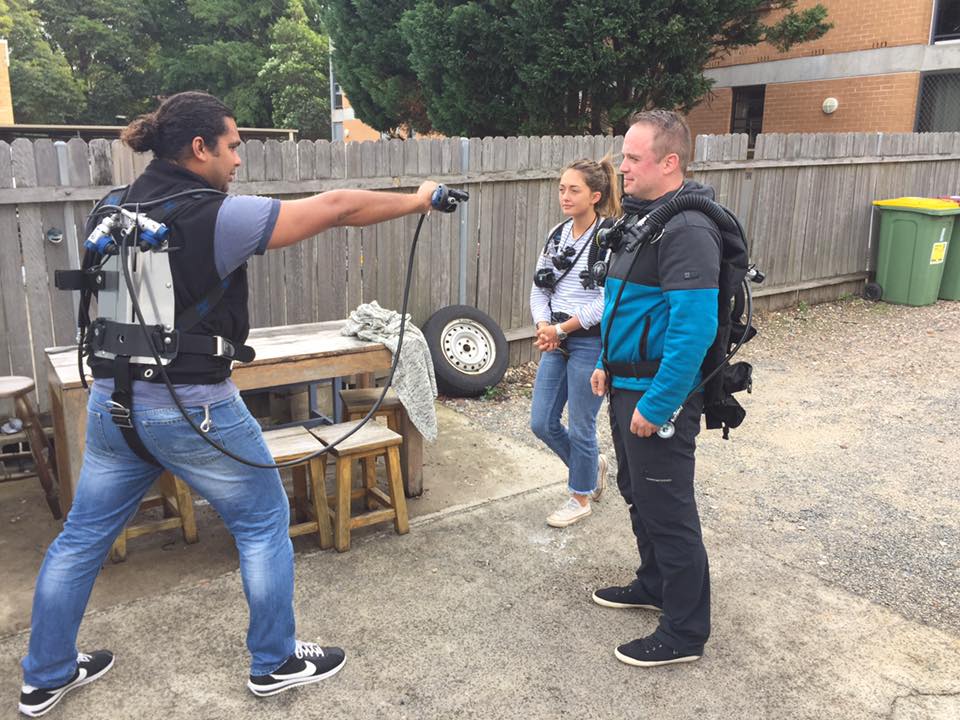Whilst I was in Palau, Christophe Bailhache and Richard Vevers suggested that if I ever get the chance I should do a GUE Fundamentals course, and to my delight, whilst I was in Bali, Jayne emailed asking if I’d like to complete one! So of course, I said yes, and the course was quickly organised once I was home by the wonderful Liam from GUE with Duncan from Dive Centre Bondi.
Richard and Christophe had told me that my buoyancy would never be the same after a GUE Fundamentals course, and they were right. I started the course swimming like a silly sea horse, and ended the course feeling a lot more like an underwater gangster.
The whole point of the GUE Fundamentals course is to improve buoyancy and trim, with an introduction into some good safety habits if tec diving is to be pursued, and to basically just make you a more confident diver. It dares you to be neutral. As a dive master, I thought my buoyancy was ok, however I knew it could definitely be improved, especially now that I had the added task of managing my beautiful camera set up form Reef Photo and Video, and I couldn’t wait to get in the water and go back to basics.
I was welcomed at Dive Centre Bondi by Duncan and David Patel (my instructor) by telling myself and Jonny, my dive buddy, to go get a coffee (I was stoked about this, having just come back from Bali where you weren’t allowed to drink coffee before freediving), and to get ready for a day of intense theory and a pool session. One of the first things we covered in theory was the correct body position to take while you dive, or ‘trim’ as it is called in the dive world, and much to my delight it was my beloved banana shape that I had been avoiding as a freediver in Bali. After discussing correct positioning, kicking techniques and breathing we headed to the pool to complete our swim test and to reshape our kicks.

We started the second day by practicing some safety drills on the land, and then moved into the water so we could work on our trim and kicks. At first I felt silly practicing the drills on land, however David assured me that the muscle memory I would develop from it would pay off in the water, and he was right. Once in the water, there was so much to focus on, especially the new feeling of really being neutral in the water. The drills were difficult at first, but with David’s endless patience and wisdom, both myself and Jonny advanced quickly, and the drills became easier.

The following weekend we continued with our drills, and a new obstacle was added to the task that I had to overcome. Having not done my dry suit course yet, I wasn’t comfortable using my beautiful (and incredibly warm) new Waterproof dry suit as I’d never worn one before, so I was freezing in my 5mm with a hood and vest (to put things into perspective, I get cold in 30 degree water in a 3mm). Jonny and David seemed to be fine with the temperature, however I had never felt colder, and removing my mask underwater and swimming for 30 seconds without it on was not very appealing to me at the time, and when the moment came to do it, I was greeted by not only a rush of icy water, but a minor brain freeze as well. David, being the incredibly intuitive and kind person that he is, had pre-empted my intolerance to the cold (I like to tell people I am a tropical fish, not a temperate one), and had brought a hot water bottle for me in my surface interval! So, I sat snuggly and warmly looking over Camp Cove eating my weight in mandarins, instead of fighting off hyperthermia.

This course is easily one of the most rewarding dive courses I have ever done. In just two weekends I’ve realised what it is to be truly neutrally buoyant, and I have also learnt to do most of the calculations my dive computer does for me automatically, in my head. The confidence this has given me whilst diving is tremendous. Having had dive computers fail on me in the past it’s incredibly reassuring to know that when it happens, I can surface safely, and that when it comes to air consumption, I can easily ascertain whether I have enough to return to a buoy line or surface immediately. The skill I am most happy to have gained from this course however, is knowing that regardless of how cold and tired I might be, or how blocked my ears are, I am capable of maintaining my buoyancy and cool whilst dealing with whatever situation has presented itself. There will be no more accidentally crashing into coral for me during baseline surveys, and there will be no more accidentally getting tangled in my smb when I inflate it. Regardless of your dive experience level, I think the GUE Fundamentals course has a lot to offer for everyone, whether it’s just refreshing skills you have already learnt, or learning something completely new, this course has changed my diving for the better and I couldn’t be more excited to continue practicing these skills (and hopefully complete some other GUE courses in the future).

Photo by David Patel